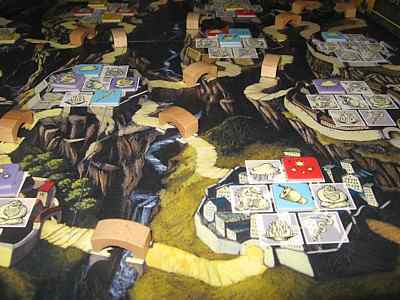Welcome to an Abstract Shangri La
The Bridges of Shangri La is a solid abstract that offers enough interesting decisions and strategic options to keep you coming back for more.
The Bridges of Shangri La is essentially a battle between you and 2 or 3 other players. It’s cloaked in an Oriental theme of master teachers and students, but it feels much more like a war.
You begin by taking turns placing one of each of your 7 master tile types – Healers, Dragonbreeders, Firekeepers, Priests, Rainmakers, Astrologers, and Yeti-whisperers – in some of the 12 (or 13, with four players) villages on the board. Tiles serve as both masters and students. The only difference is whether a tile is the only one on a space (master) or whether it’s stacked on top of another tile (student).
After initial placements, you have three options.
- Place a single master tile.
- Place two student tiles (on top of masters).
- Move all students from one village to another.
It is this movement that is really the key to the game. (Even the directions tell you so.)
 When you move students from one village to another, they cross a wooden bridge. For some reason, that bridge breaks after they pass over it, and it is removed from the game. Obviously, no students may ever take that now-dangerous path again in either direction.
When you move students from one village to another, they cross a wooden bridge. For some reason, that bridge breaks after they pass over it, and it is removed from the game. Obviously, no students may ever take that now-dangerous path again in either direction.
Eventually, a village can become isolated when all of the several bridges leading to it have been destroyed by the students’ travels. A green (glass) “Stone of the Wise Men” is placed on such a village. When all of these stones have been placed, the game ends.
All students make the journey from one village to another, even those of your opponents. What happens when they arrive at the new village depends on the strength of the village of origin compared to the destination.
Normally you want the starting village to be stronger (have more total tiles) than the destination. Students, who move to a new village and find that there is no master of their type located there, will become a new master. Students, who find opposing masters or students of their type already in the new village, will dislodge them and send them back to the owner’s supply. Students, who find one of their own masters in the new village, will become a student of that master. If there is already a like-minded student there, the new student returns to the owner’s supply for reuse later. All students traveling to a stronger village and finding occupied spaces are returned to the owners’ supply.
At the end of the game, the player with the most masters (only) is the winner. Ties are broken by comparing the number of villages occupied by the tied players.
Even if you don’t like abstract games, there is something about The Bridges of Shangri La that makes it not feel too abstract. There is a lot of opportunity for thought and planning, but this will lead to analysis paralysis for some players. The bits are fine for their purpose, but the board itself is rather dark and dreary.
The Bridges of Shangri La presents a challenge that feels battle-like or war-like despite the master-student theme. As long as you can keep everyone moving, which can be difficult as planning ahead is tough and the options are many, you’ll enjoy a fun, strategic game that takes about an hour.
Check the price of The Bridges of Shangri La on Amazon.


Pingback:Invite Your Clans to This Fun Board Game